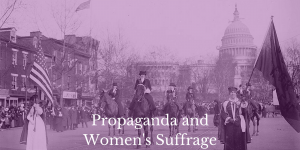Propaganda and Women's Suffrage

The student will examine propaganda posters from the American women’s suffrage movement to gain an understanding of a) the role that visual imagery played in the movement and b) the ways American suffragists used other countries and other states with full suffrage as examples of why women should have voting rights nationwide.
15 minutes (The lesson can also be lengthened into a 45 minute class lesson by using all of the posters included in the document.)
Students will understand the role that visual imagery played in the suffrage movement.
For gifted/honors students or if class time is limited, have the students research the background information ahead of time (previous class period) and bring their research to class. You can also print out the websites and distribute to the collaborative groups (see below).
- Copies of the suffrage propaganda posters (included in lesson plan PDF); one poster per collaborative group is recommended
- Copies of the Poster Analysis Document from the National Archives; one per collaborative group is recommended
- Starter/Hook: On the board, write “What is propaganda?” Ask the students to give their own definition or explanation of the word. Have them give an example of a type of propaganda that they have seen on the Internet or television. Explain to the students that during today’s class, they will learn about a form of propaganda that was used in the women’s suffrage movement in America.
- Direct Instruction:
- Provide background on women’s suffrage movement from 1900 to 1920 to the class. Explain to them that women gained suffrage in western states before the 19th Amendment and that these states were used as examples of why women should be granted voting rights in other states. You might also explain that American suffragists paid attention to other state campaigns and even other countries’ efforts to gain the vote.
- Use the NWHM’s “Crusade for the Vote” to provide background information:
- Guided Practice:
- Divide the class into collaborative groups of 3 to 4 students. Provide each group with one of the three suffrage posters (included in the lesson plan) and a copy of the NARA poster analysis worksheet.
- Have the collaborative groups complete the analysis sheet for their poster. Encourage them to think about the following questions as they work:
- What role did imagery play in the suffrage movement?
- How did the movement's leaders use propaganda to persuade people to their cause?
- Each group will choose a student representative who will rotate to the other groups and explain their poster (Student will carry it with him/her). The rotations will continue until the student representative has returned to his/her original group.
- The class will come together and discuss the questions posed to them as they were working in groups:
- What role did imagery play in the suffrage movement?
- How did the movement's leaders use propaganda to persuade people to their cause?
Students will write a free-response on the following topic: Was the use of propaganda successful in gaining the right to vote for women? Students will use their background knowledge and the primary documents to construct this response.
Optional: To extend this activity, have students write an essay on the topic and cite their evidence.
UCLA Social Studies Standard 1C: Specify the issues raised by various women and how mainstream Progressives responded to them. [Consider multiple perspectives]
UCLA Social Studies Standards Available Here
Common Core Alignment
CCSS.ELA-LITERACY.RH.9-10.1 - Cite specific textual evidence to support analysis of primary and secondary sources, attending to such features as the date and origin of the information.
CCSS.ELA-LITERACY.RH.11-12.1
Cite specific textual evidence to support analysis of primary and secondary sources, connecting insights gained from specific details to an understanding of the text as a whole.
